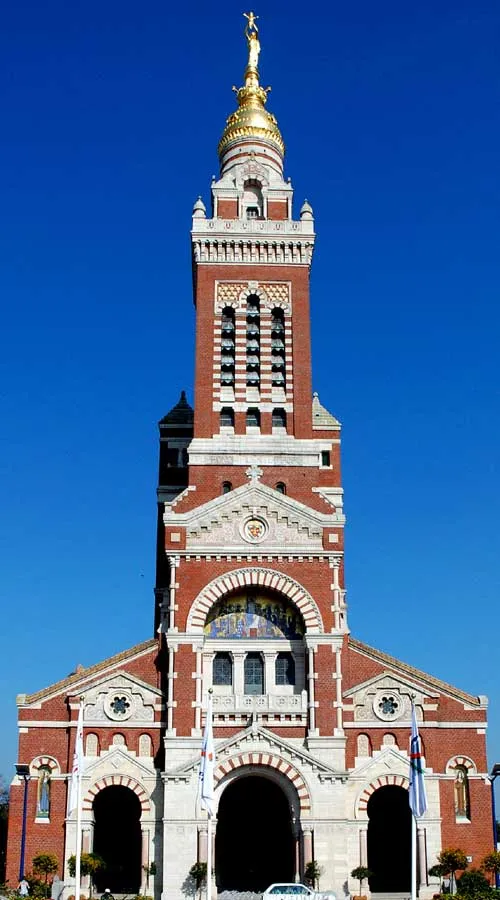
Introduction
The Basilica of Our Lady of Brebières, Basilique Notre-Dame de Brebières (French) is a Roman Catholic minor Basilica designed by Edmond Duthoit in 1897. The structure was completely destroyed during shelling in World War I and rebuilt by the original architect’s son Louis Duthoit from 1927 to 1931.
The Golden Virgin sculpture designed by Albert Roze sits atop the dome of the Basilica and became an object of fascination during World War I.
Pope Leo XIII granted a decree of canonical coronation to the venerated image in 19 June 1901. Pious legends among soldiers at the time claimed a supernatural prophecy that when a German missile hits the prominent Marian statue above the church, the First World War would finally end.
Notre Dame de-Brebières has been one of the high places of Marian worship in Picardy since the 11th and 12th centuries. At the end of the 19th century, the pilgrimage experienced a revival of fervor with the whole of Marian devotion (as in La Salette and Lourdes).
The Notre-Dame de Brebières basilica was built at the instigation of Anicet Godin, priest-dean of Albert from 1882 to 1913. It replaced the parish church, built after the fire of 1660 and finished in 1705. Having become too small to accommodate the ever-increasing number of faithful due to the development of the city during the industrial revolution, it was decided to destroy the existing church and build a new one.
In 1895, at the time of its inauguration, Pope Leo XIII conferred the honorary title of minor basilica on the new church. He specified in his papal bull his ambition for the basilica: “Albert would have to become the Lourdes of the North”.
The construction of the basilica required the concreting of the bed of the Anchor which flows under the choir over a length of twenty-seven meters. The elevation was carried out on the plans of the architect Edmond Duthoit from 1885 to 1897. After his death in 1889, the conduct of the work was entrusted to Henri Bernard, his main collaborator.
History of Basilique Notre-Dame de Brebières, Albert
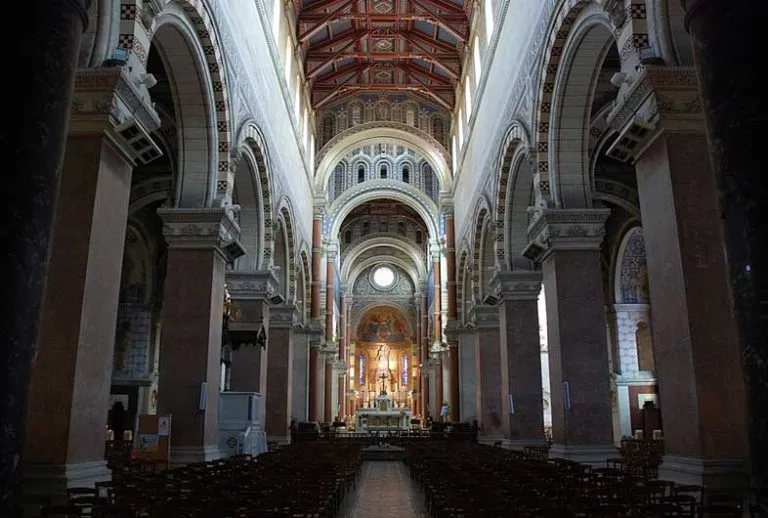
The Basilica started out as a parish church. In the 11th century many Catholics made pilgrimages to the parish church on the site to see a statue called “Our Lady of the Ewes” according to legend it had been found by a shepherd in the Middle Ages. Catholics passed around rumors of miracles related to the statue. In 1834 Pope Gregory XVI noticed the growth of the statue’s legend and built a larger church at the location. Throughout the years grander churches were built and finally the Basilica of Our Lady of Brebières. A new large statue of Marian Art entitled The Golden Virgin was attached to the dome.
Construction on the Basilica began in 1885 and lasted until 1897. It was constructed with stone and red brick: the bell tower rises more than 200 ft (61 m). In 1901 Pope Leo XIII consecrated the church and, seeing the Golden Virgin, he called the Basilica the “Lourdes of the North”. The sculpture was fastened to the 76 m (249 ft 4 in) bell tower.
The Golden Virgin sculpture which stood on the dome of the Basilica was damaged During Battle of Albert 1914. In 1914 the French and Germans staged their troops in Albert, France and the German troops suspected that the French may use the bell tower as an observation post to direct military maneuvers, so beginning in October 1914 they shelled the dome.
By 7 January 1915 the dome was destroyed and by 21 January 1915 the base of The Golden Virgin was hit and the statue was knocked sideways past 90 degrees. The Madonna and Child statue above the dome was damaged, separated, recast and placed upon the newly reconstructed basilica.
Destruction
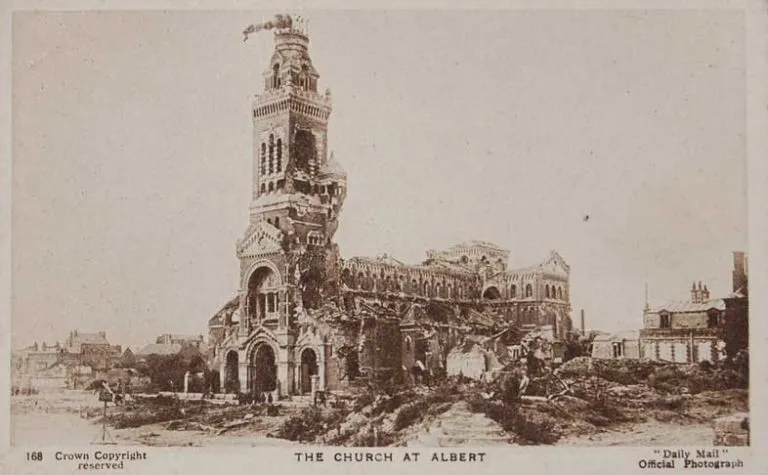
Albert’s basilica was completely destroyed during the Great War. In 1915, a shell hit the dome supporting the statue, which bowed, but remained in a precarious and impressive balance. This event gave birth to a legend: “When the Virgin of Albert falls, the War will end said hairy and tommies. The photograph of this destroyed basilica and its “Leaning Virgin” was sent around the world by soldiers to their families – as a postcard – and contributed to its planetary fame. In april 1918, during the last German offensive, the Battle of the Kaiser, the basilica was destroyed under the shells and the statue of the golden Virgin crashed to the ground.
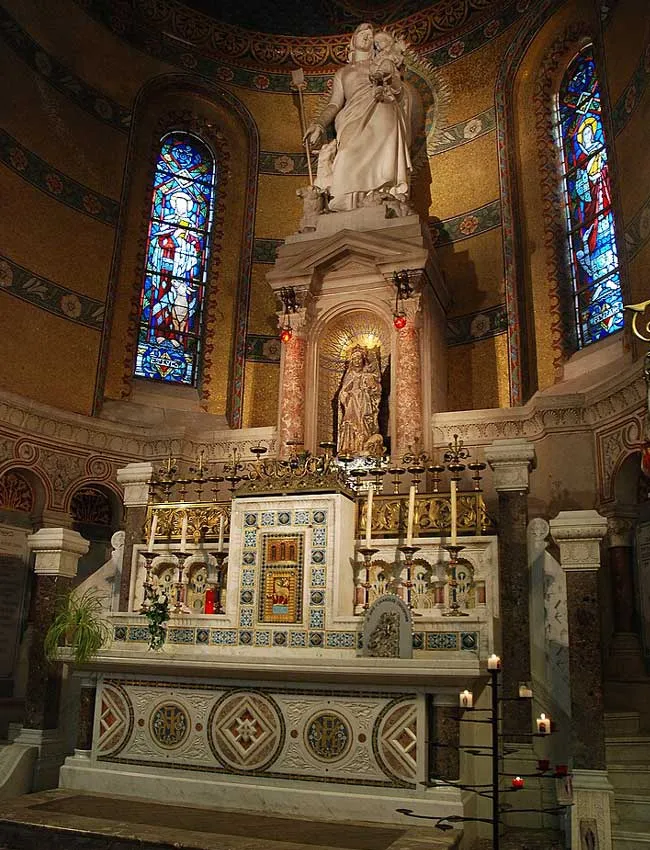
Rebuilding
The basilica was rebuilt identically by the architect Louis Duthoit, son of Edmond Duthoit, between 1927 and 1931. The interior decoration partly resumed the original decoration.
The bell tower has been redone identically. A replica of the “Golden Virgin” also due to Albert Roze was re-installed during the reconstruction of the building from 1927 to 1929. The roof of the dome and the gilding of the statue have recently been restored.
Centenary of the Battle of the Somme
As part of the ceremonies commemorating the centenary of the Battle of the Somme, American singer Barbara Hendricks gave a Peace Concert accompanied by the Orchester de Picardie on Friday July 1 , 2016 at 10 p.m. at the Basilica of Albert.
Architecture
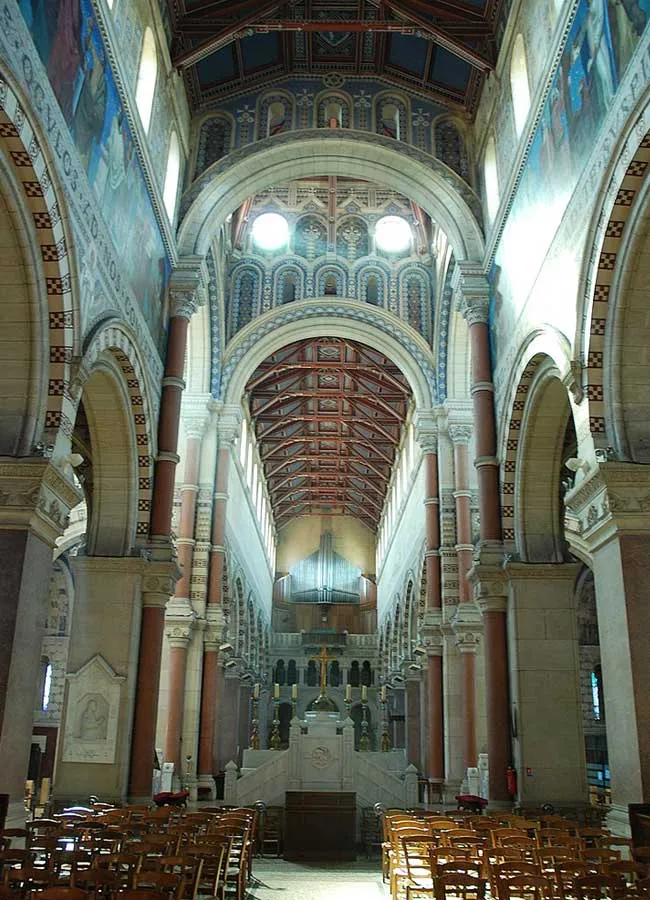
The Notre-Dame de Brebières basilica is an example of a neo-Byzantine style building. This vast brick building was built from 1885 to 1897 by the Picard Edmond Duthoit, architect and orientalist who defined his work as follows:
“The architecture of Albert’s church is the synthesis of what I saw: my bell tower is a minaret from Tlemcen or Seville. On the palaces of Siena or Florence, one sees consoles which look terribly like the cornices of the new church; those of the apses, with their half-cupolas and corbels, originated in Syria, the upper clerestory is found in all the basilicas of Syria, Italy, Sicily and Corsica. The large horseshoe arches, which separate the aisles from the main nave, are borrowed from the great mosque of Tlemcen.
The Kairouan mosque provided me with the arrangement of the abacus, the capitals, my portal will recall the arrangements that I admired at the mosque of Tunis Note. Finally, I will be happy that when looking at the decoration of the apse, the tourist thinks of that of the church of Monreale, near Palermo. I cannot give a name to this mixture; all these elements which compose it are good: may their combination not be disagreeable to visitors! The main facade is formed by a porch with three portals located under the bell tower. The floor and the facade are decorated with mosaics.
The bell tower culminates at 76 m. Its upper part is composed of a dome bearing a Virgin covered with 40,000 gold leaves, six meters high (work by Albert Roze), presenting the Child Jesus : the child’s arms form a cross Note. The dome was manufactured in the Monduit workshops. An exterior gallery located sixty meters above the ground makes it possible to go around the bell tower and offers a remarkable view of the city and its surroundings.
The plan of the building recalls that of the first Christian basilicas with a large apse formed by a raised chapel and framed by two apsidioles leaning on either side on the transept also terminated to the north and south by two apsidioles.
The crossing of the transept is surmounted by a small quadrangular lantern tower. A nave of five bays flanked by two side aisles extends the building. Each of the bays communicates with the side aisles which open on each side onto five chapels. A decorated frame and a coffered ceiling replace the traditional vaults. The length of the building is 70 m, its width is 35 m at the transept. The ceiling height is 23 m.
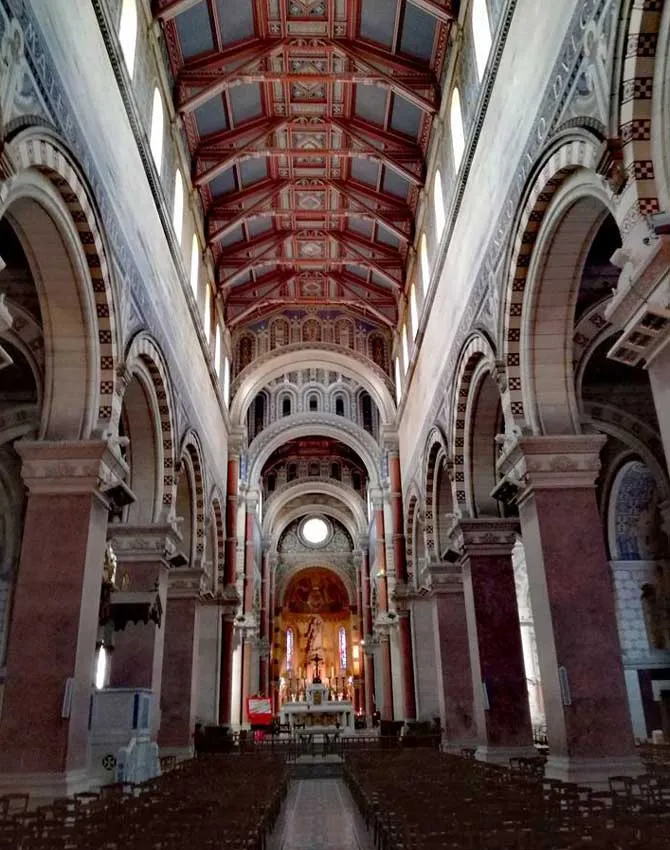
Decor
Rebuilt identically after the destruction of the Great War by the son of the architect, Louis Duthoit, between 1927 and 1931 with the help of his son 6 , the basilica has regained part of its rich interior decoration.
The decoration of the building is remarkable. The entrance to the basilica takes the form of a narthex whose ceiling is made up of three domes on a square plan which rest on wide transverse arches. Each portal is surmounted by a Byzantine-style mosaic by Albert Pollart.
Stained Glass and Mosaics
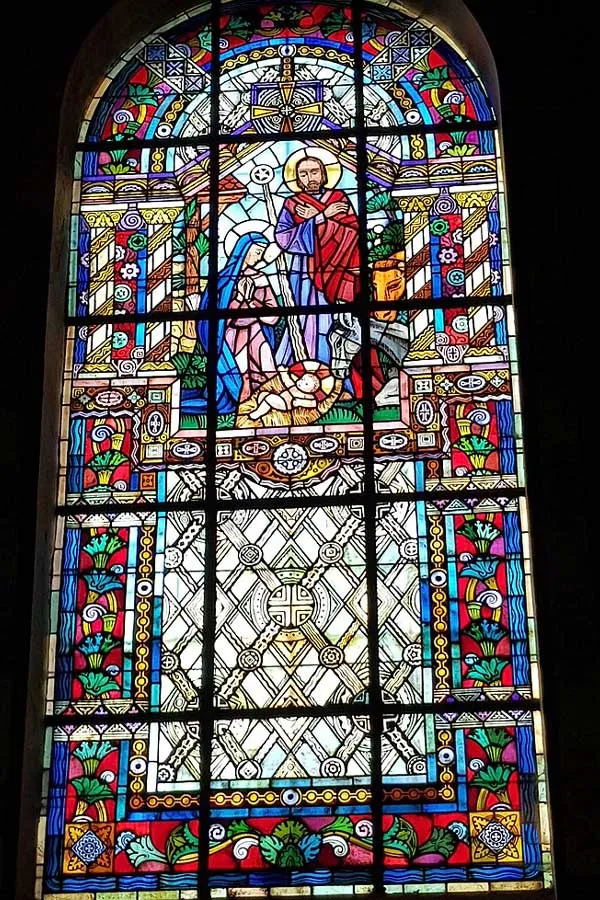
In the apse, the mosaic of the coronation of the Virgin was made by Giandomenico Facchina on drawings by Georges Grellet. Destroyed during the Great War, it was rebuilt according to the original designs during the interwar period.
The set of mosaics (floor, walls and furniture) was designed by Albert Polart and Le Breton and produced by Jean Gaudin. The stained glass windows are by Jacques Grüber.
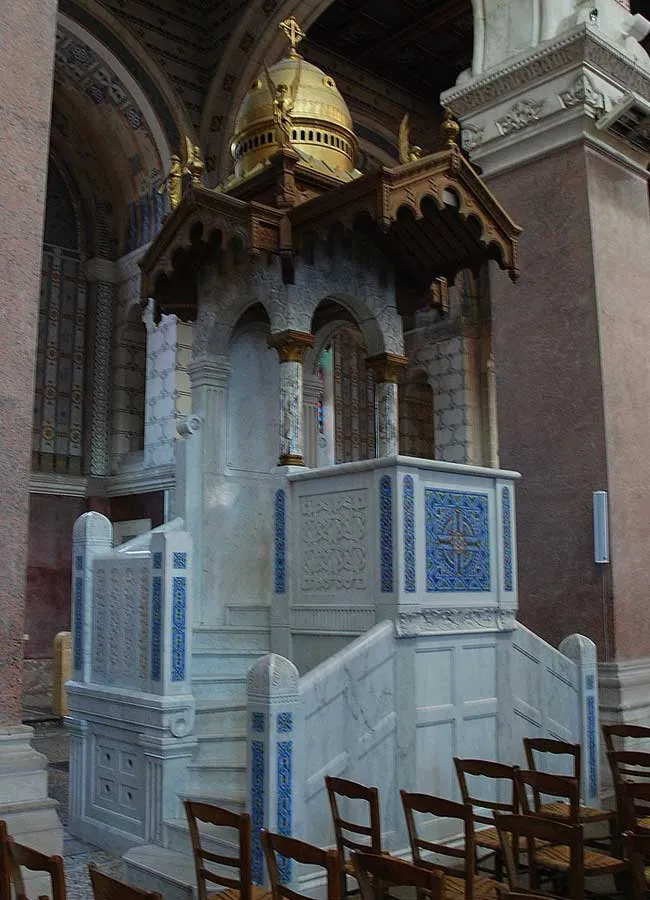
Sculptures
The statue of Notre-Dame de Brebières which is exhibited in a niche in the apse dates from the 14th century. The 2014 restoration restored it to its original colours.
Surmounting Notre-Dame de Brebières, a large statue of the Virgin, The Madonna of the Sheep in Carrara marble by the sculptor Eugène Delaplanche was destroyed by the bombardments. The current statue replica of the previous one is the work of Albert Roze.
Works sculpted by Albert Roze: commemorative medallion of the Duthoits, medallion of Saint Dominic, medallion of A. Gosset, priest-dean of Albert, statues of the mutilated Virgin of Mercy, of Saint Gervais and Saint Protais, busts of Saint Vincent de Paul and Saint Ignatius of Loyola.
Statues of Joan of Arc, Saint Thérèse of Lisieux and the Virgin of Mercy by Anne-Marie Roux. The sculptor Louis Leclabart from the workshop of Albert Roze also participated in the decoration of the basilica.
Paintings
The murals are by Victor-Ferdinand Bourgeois. The basilica also contains two paintings by Adrien Duthoit (eldest son of Edmond Duthoit): The Announcement to the Shepherds and Sainte- Gertrude.
Organs
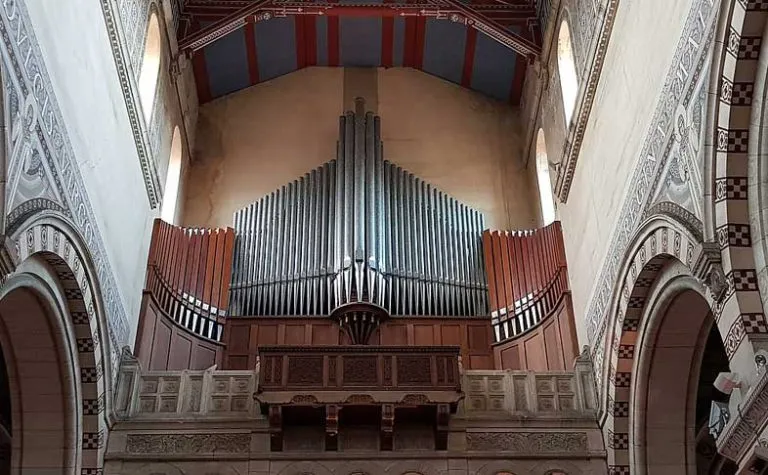
The gallery organ inaugurated in 1901 was the work of Joseph Gutschenritter, director of the Joseph Merklin factory. The Great War having destroyed the basilica, the organs were completely destroyed. They were replaced, in 1958, by an instrument built by Jacquot-Lavergne, with re-use of the pipework of the old choir organ. The organ is made up of 1,944 pipes made of beech or a tin and lead alloy.
In 2018, the Lille organ builder, Antoine Pascal, undertook work to rescue the organ attacked by worms, 700 pipes were dismantled, cleaned and treated, sealing skins redone. The condition of the wind tunnel seals would require repair. Antoine Pascal estimated the value of Albert’s gallery organ at 400,000 euros.
The Choir Organ
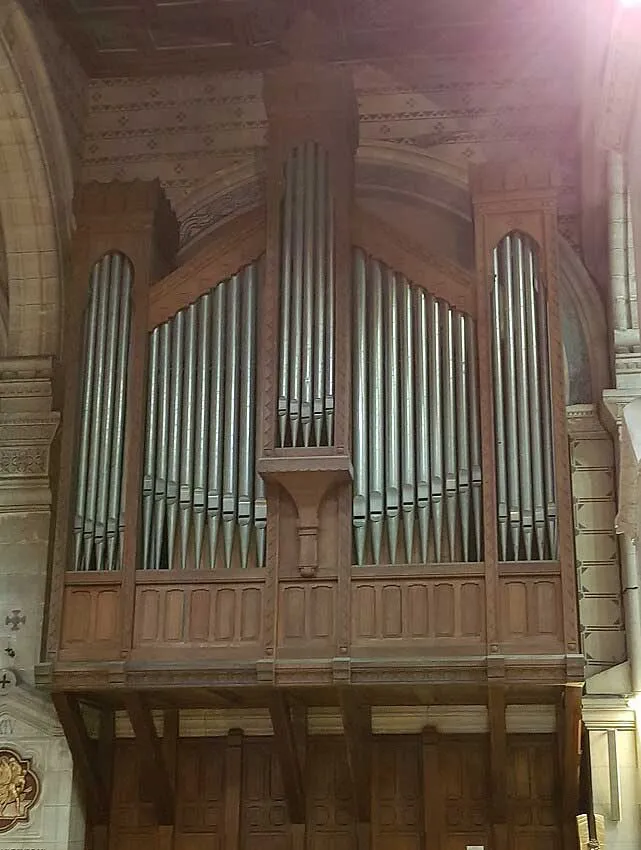
The choir organ, also made by Jacquot-Lavergne, was installed in the basilica at the same time as the gallery organ. It is a unit system organ that reuses an older case from the Joseph Merklin manufactory.
Treasure
The treasury preserves various liturgical objects: chalice, paten, ciborium, altar canons, ornate Roman missals, mitre, chasuble, stole, chalice veil, maniple, etc.
Two silver crowns encrusted with jewels, works of the Parisian jewelry workshop Mellerio (1901) are kept by the Treasury of Notre-Dame d’Amiens cathedral.

The Bells
Inside the bell tower, the two-storey wooden belfry houses four brass bells (78% copper and 22% tin) cast by the Wauthy company of Sin-le-Noble, next door of Douai in 1934 including:
“Marie de Brebières”, the bumblebee (6,300 kg); “Marie Louise” and “Christopherine”. The clapper of each of these three worn bells was replaced in 2018. It represents 3.5% of the weight of the bell and was made of steel.
Feast Day - First Sunday of September
The Feast Day of Basilique Notre-Dame de Brebières is celebrated on the first Sunday of September each year. The basilica, located in the town of Albert in the Hauts-de-France region of France, is dedicated to the Virgin Mary under the title of Our Lady of Brebières. On the feast day, special religious ceremonies, processions, and other festivities take place to honor the patroness and commemorate the significance of the basilica in the local community.
Contact Info
Basilique Notre-Dame de Brebières,
20, Rue Anicet Godin,
80300, Albert, France.
Phone No.
Tel : +33 3 22 75 09 54
Accommodations
How to reach the Basilica
Albert – Picardie Airport serving Albert, a commune of the Somme department in the Picardy region of northern France is the nearby Airport to the Basilica.
Gare d’Albert Train Station in Albert, Somme, France is the nearby Train Station to the Basilica.








